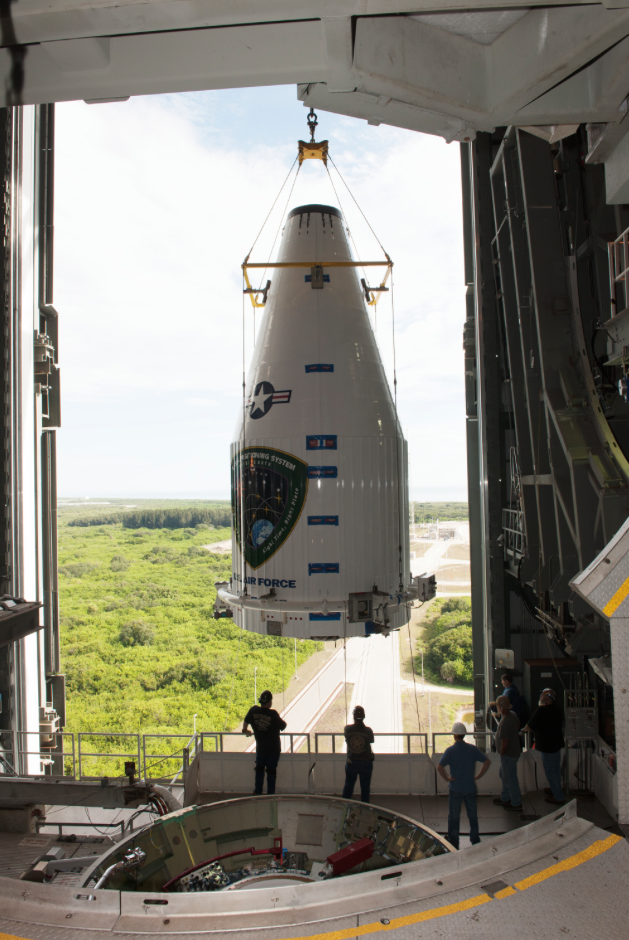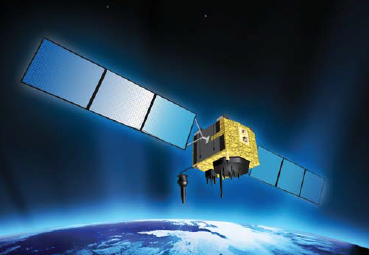[SatNews] The signals are so accurate that time can be measured to within a millionth of a second, velocity within a fraction of a mile per hour, and location to within feet.
Everything is progressing toward the GPS IIF-10 launch for the United States Air Force. The mission is set to liftoff on a ULA Atlas V rocket on Wednesday, July 15 from Space Launch Complex 41 at Cape Canaveral Air Force Station in Florida. Webcast is available here.
Today's L-4 forecast shows a 70 percent chance of favorable weather conditions for launch. The launch window is 11:36 – 11:54 EDT.
Launch Forecast Summary:

A Rocket With A View. The Air Force's GPS IIF-10 satellite, encapsulated inside a 4-meter payload fairing, is mated to an Atlas V rocket at the Vertical Integration Facility or VIF. Courtesy of ULA.
Overall probability of violating weather constraints: 30 percent
Primary concern: Cumulus Clouds
Overall probability of violating weather constraints for 24 hour delay: 30 percent
Primary concern: Cumulus Clouds
All times eastern daylight time. Launch July 15, launch window 11:36-11:54 A.M.
Mission Description: GPS satellites serve and protect our warfighters by providing navigational assistance for U.S. military operations on land, at sea, and in the air. Civilian users around the world also use and depend on GPS for highly accurate time, location, and velocity information.
GPS IIF-10 is one of the next-generation GPS satellites, incorporating various improvements to provide greater accuracy, increased signals, and enhanced performance for users.
Launch Notes: GPS IIF-10 marks the 55th Atlas V launch since the vehicle’s inaugural launch in 2002 and the 27th flight of the 401 configuration. Every operational GPS mission has launched on a ULA or heritage rocket.
A United Launch Alliance Atlas V 401 launch vehicle will deliver the GPS IIF-10 satellite to semi-synchronous circular orbit. Liftoff will occur from Space Launch Complex 41 at Cape Canaveral Air Force Station, Florida.
The Navstar Global Positioning System (GPS) is a constellation of satellites that provides navigation data to military and civilian users worldwide. The system is operated and controlled by the 50th Space Wing, located at Schriever Air Force Base, Colorado.

GPS IIF-10 Courtesy of ULA.
GPS utilizes 24 satellites, in six different planes, with a minimum of four satellites per plane, positioned in orbit approximately 11,000 nautical miles above the Earth’s surface.
The satellites continuously transmit digital radio signals pertaining to the exact time (using atomic clocks) and exact location of the satellites. The GPS IIF series have a design life of 12 years. With the proper equipment, users can receive these signals to calculate time, location, and velocity. The signals are so accurate that time can be measured to within a millionth of a second, velocity within a fraction of a mile per hour, and location to within feet. Receivers have been developed for use in aircraft, ships, land vehicles, and to hand carry.
As a result of increased civil and commercial use as well as experience in military operations, the USAF has added the following capabilities and technologies to the GPS IIF series to sustain the space and control segments while improving mission performance:
- Two times greater predicted signal accuracy than heritage satellites.
- New L5 signals for more robust civil and commercial aviation.
- An on-orbit, reprogrammable processor, receiving software uploads for improved system operation.
- Military signal “M-code” and variable power for better resistance to jamming hostile meeting the needs of emerging doctrines of navigation warfare.